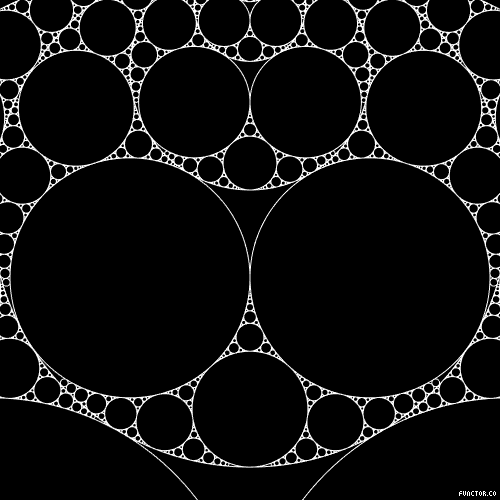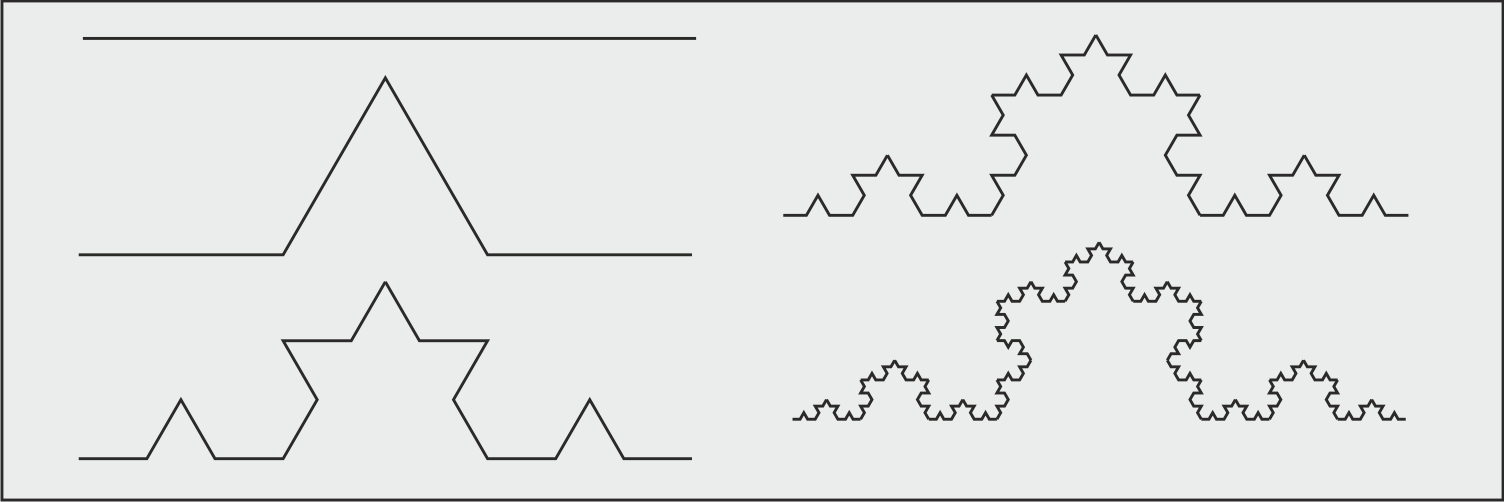cas/definition.php (people or term)

Fractals
While Fractals are visually striking on their own, such topological regularities in complex systems are significant not only due to their inherent beauty , but because of the dynamics at work which generate such patterns.
Read on:
The Sierpinski Fractal shown here is a nice example of a scale-free/power law system. At each level of zoom we encounter the same pattern. Such self-similar structures follow power-law distributions of their components: that is to say, a few elements within the overall pattern are very large, but there are many more elements within the structure that become vanishingly small.
Let us take a look at another well known fractal, the Koch Curve. The Fractal demonstrates how multiple, {{timeiterative}} have the power of generating something highlighly unexpected:

First four iterations of the Koch Curve
We begin with a line and a simple three step rule protocol:
- for every line segment break it into three equal segments;
- Form an equilateral triangle wherever the center segment falls (removing the base)
- Repeat this process for each of the newly created line segments.
As seen in the image above, a repeated simple rule set is all that is required to generate a high level of complexity. This is the basic principle at work in creating all Fractals - where basic instructions generate an output, whose new properties (going from one line segment to four line segments), become the new context upon which to re-apply the rule.
While we can obtain a lot of richness from such phenomena, it would be incorrect to state that the resulting figure 'adapts' or 'learns' - instead it is more accurate to state that it 'unfolds' over multiple iterations.
Cite this page:
Wohl, S. (2022, 1 June). Fractals. Retrieved from https://kapalicarsi.wittmeyer.io/definition/fractals-1
Fractals was updated June 1st, 2022.
Nothing over here yet
Navigating Complexity © 2015-2025 Sharon Wohl, all rights reserved. Developed by Sean Wittmeyer
Sign In (SSO) | Sign In
Related (this page): Nested Orders (23), Scale-Free (217),
Section: terms
Non-Linearity Related (same section): Related (all): Urban Modeling (11, fields), Resilient Urbanism (14, fields), Relational Geography (19, fields), Landscape Urbanism (15, fields), Evolutionary Geography (12, fields), Communicative Planning (18, fields), Assemblage Geography (20, fields), Tipping Points (218, concepts), Path Dependency (93, concepts), Far From Equilibrium (212, concepts),
Nested Orders Related (same section): Related (all): Urban Modeling (11, fields), Urban Informalities (16, fields), Resilient Urbanism (14, fields), Self-Organized Criticality (64, concepts), Scale-Free (217, concepts), Power Laws (66, concepts),
Emergence Related (same section): Related (all): Urban Modeling (11, fields), Urban Informalities (16, fields), Urban Datascapes (28, fields), Incremental Urbanism (13, fields), Evolutionary Geography (12, fields), Communicative Planning (18, fields), Assemblage Geography (20, fields), Self-Organization (214, concepts), Fitness (59, concepts), Attractor States (72, concepts),
Driving Flows Related (same section): Related (all): Urban Datascapes (28, fields), Tactical Urbanism (17, fields), Relational Geography (19, fields), Parametric Urbanism (10, fields), Landscape Urbanism (15, fields), Evolutionary Geography (12, fields), Communicative Planning (18, fields), Assemblage Geography (20, fields), Open / Dissipative (84, concepts), Networks (75, concepts), Information (73, concepts),
Bottom-up Agents Related (same section): Related (all): Urban Modeling (11, fields), Urban Informalities (16, fields), Resilient Urbanism (14, fields), Parametric Urbanism (10, fields), Incremental Urbanism (13, fields), Evolutionary Geography (12, fields), Communicative Planning (18, fields), Rules (213, concepts), Iterations (56, concepts),
Adaptive Capacity Related (same section): Related (all): Urban Modeling (11, fields), Urban Informalities (16, fields), Tactical Urbanism (17, fields), Parametric Urbanism (10, fields), Landscape Urbanism (15, fields), Incremental Urbanism (13, fields), Evolutionary Geography (12, fields), Feedback (88, concepts), Degrees of Freedom (78, concepts),
